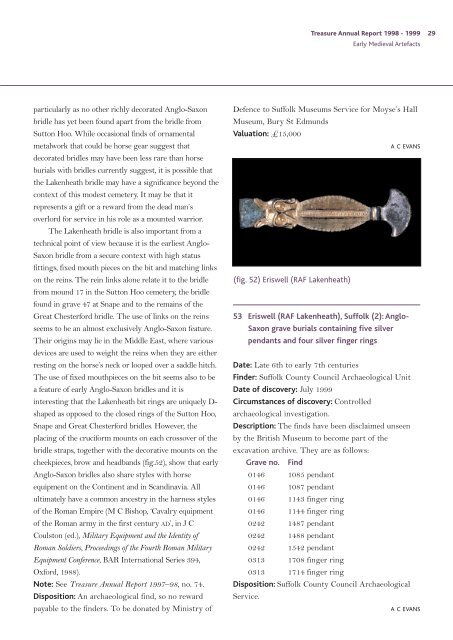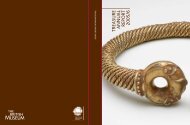Treasure Annual Report 1998-1999 - Portable Antiquities Scheme
Treasure Annual Report 1998-1999 - Portable Antiquities Scheme
Treasure Annual Report 1998-1999 - Portable Antiquities Scheme
You also want an ePaper? Increase the reach of your titles
YUMPU automatically turns print PDFs into web optimized ePapers that Google loves.
<strong>Treasure</strong> <strong>Annual</strong> <strong>Report</strong> <strong>1998</strong> - <strong>1999</strong> 29<br />
Early Medieval Artefacts<br />
particularly as no other richly decorated Anglo-Saxon Defence to Suffolk Museums Service for Moyse’s Hall<br />
bridle has yet been found apart from the bridle from Museum, Bury St Edmunds<br />
Sutton Hoo. While occasional finds of ornamental Valuation: £15,000<br />
metalwork that could be horse gear suggest that A C EVANS<br />
decorated bridles may have been less rare than horse<br />
burials with bridles currently suggest, it is possible that<br />
the Lakenheath bridle may have a significance beyond the<br />
context of this modest cemetery. It may be that it<br />
represents a gift or a reward from the dead man’s<br />
overlord for service in his role as a mounted warrior.<br />
The Lakenheath bridle is also important from a<br />
technical point of view because it is the earliest Anglo-<br />
Saxon bridle from a secure context with high status<br />
fittings, fixed mouth pieces on the bit and matching links<br />
on the reins. The rein links alone relate it to the bridle<br />
from mound 17 in the Sutton Hoo cemetery, the bridle<br />
found in grave 47 at Snape and to the remains of the<br />
Great Chesterford bridle. The use of links on the reins<br />
seems to be an almost exclusively Anglo-Saxon feature.<br />
Their origins may lie in the Middle East, where various<br />
devices are used to weight the reins when they are either<br />
resting on the horse’s neck or looped over a saddle hitch.<br />
The use of fixed mouthpieces on the bit seems also to be<br />
a feature of early Anglo-Saxon bridles and it is<br />
interesting that the Lakenheath bit rings are uniquely Dshaped<br />
as opposed to the closed rings of the Sutton Hoo,<br />
Snape and Great Chesterford bridles. However, the<br />
placing of the cruciform mounts on each crossover of the<br />
bridle straps, together with the decorative mounts on the<br />
cheekpieces, brow and headbands (fig.52), show that early<br />
Anglo-Saxon bridles also share styles with horse<br />
equipment on the Continent and in Scandinavia. All<br />
ultimately have a common ancestry in the harness styles<br />
of the Roman Empire (M C Bishop, ‘Cavalry equipment<br />
of the Roman army in the first century AD’, in J C<br />
Coulston (ed.), Military Equipment and the Identity of<br />
Roman Soldiers, Proceedings of the Fourth Roman Military<br />
Equipment Conference, BAR International Series 394,<br />
Oxford, 1988).<br />
Note: See <strong>Treasure</strong> <strong>Annual</strong> <strong>Report</strong> 1997–98, no. 74.<br />
Disposition: An archaeological find, so no reward<br />
payable to the finders. To be donated by Ministry of<br />
(fig. 52) Eriswell (RAF Lakenheath)<br />
53 Eriswell (RAF Lakenheath), Suffolk (2): Anglo-<br />
Saxon grave burials containing five silver<br />
pendants and four silver finger rings<br />
Date: Late 6th to early 7th centuries<br />
Finder: Suffolk County Council Archaeological Unit<br />
Date of discovery: July <strong>1999</strong><br />
Circumstances of discovery: Controlled<br />
archaeological investigation.<br />
Description: The finds have been disclaimed unseen<br />
by the British Museum to become part of the<br />
excavation archive. They are as follows:<br />
Grave no. Find<br />
0146 1085 pendant<br />
0146 1087 pendant<br />
0146 1143 finger ring<br />
0146 1144 finger ring<br />
0242 1487 pendant<br />
0242 1488 pendant<br />
0242 1542 pendant<br />
0313 1708 finger ring<br />
0313 1714 finger ring<br />
Disposition: Suffolk County Council Archaeological<br />
Service.<br />
A C EVANS





